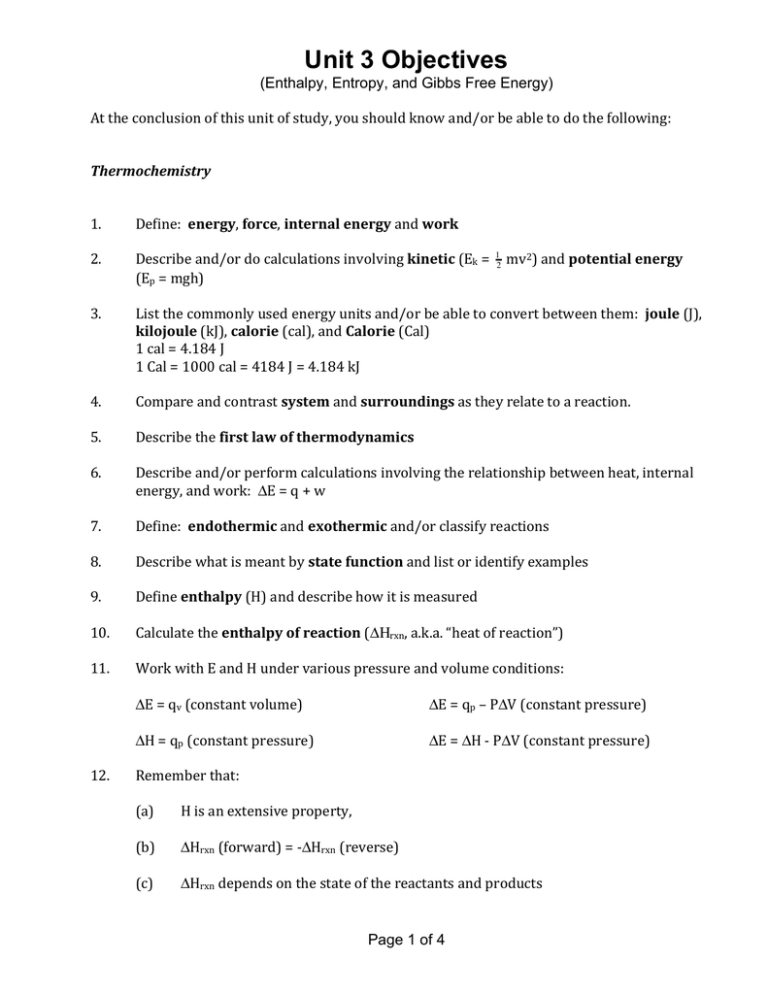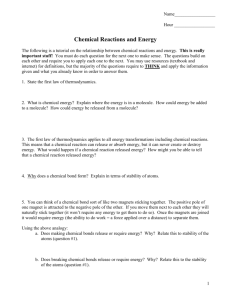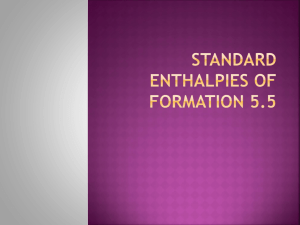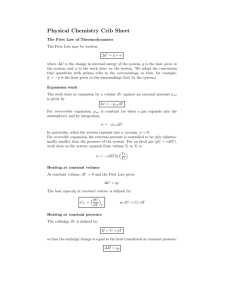Document 10287651
advertisement

Unit 3 Objectives (Enthalpy, Entropy, and Gibbs Free Energy) At the conclusion of this unit of study, you should know and/or be able to do the following: Thermochemistry 1. Define: energy, force, internal energy and work 2. Describe and/or do calculations involving kinetic (Ek = 12 mv2) and potential energy (Ep = mgh) 3. List the commonly used energy units and/or be able to convert between them: joule (J), kilojoule (kJ), calorie (cal), and Calorie (Cal) 1 cal = 4.184 J 1 Cal = 1000 cal = 4184 J = 4.184 kJ 4. Compare and contrast system and surroundings as they relate to a reaction. 5. Describe the first law of thermodynamics 6. Describe and/or perform calculations involving the relationship between heat, internal energy, and work: ΔE = q + w 7. Define: endothermic and exothermic and/or classify reactions 8. Describe what is meant by state function and list or identify examples 9. Define enthalpy (H) and describe how it is measured 10. Calculate the enthalpy of reaction (ΔΗrxn, a.k.a. “heat of reaction”) 11. Work with E and H under various pressure and volume conditions: ΔE = qv (constant volume) ΔE = qp – PΔV (constant pressure) ΔH = qp (constant pressure) ΔE = ΔH -­‐ PΔV (constant pressure) 12. Remember that: (a) H is an extensive property, (b) ΔHrxn (forward) = -­‐ΔHrxn (reverse) (c) ΔHrxn depends on the state of the reactants and products Page 1 of 4 Unit 3 Objectives (Enthalpy, Entropy, and Gibbs Free Energy) 13. 14. 15. 16. 17. 18. 19. 20. 21. Define: calorimetry, calorimeter, heat capacity, molar heat capacity, and specific heat Calculate the amount of heat gained/lost for a substance undergoing a temperature: qp = cmΔT or qv = CcalΔT Describe how the heat of reaction can be determined using constant-­‐pressure or constant-­‐volume (bomb) calorimetry Calculate the heat of reaction using constant-­‐pressure or constant-­‐volume (bomb) calorimetry data Describe Hess’s law and apply it to determine the heat of reaction Define: enthalpy of formation (ΔHf), standard enthalpy (ΔHo), and standard enthalpy of formation (ΔH of ) Use Hess’s law and standard enthalpy of formation values (Appendix C) to determine the enthalpy of reaction (ΔH orxn ) o o o !H rxn != "n!H rxn, products # "m!H rxn, reactants Compare the usefulness of various foods/fuels based on their thermodynamic and environmental characteristics. Calculate the heat of reaction using bond energy values. Discuss the advantages and disadvantages of using bond energies rather than standard heats of formation to determine heats of reaction. Entropy 22. Define Entropy (S) and how it is determined. 23. Define microstate (W), determine the number of microstates for a given process, and calculate the entropy: S = k ln W (k = 1.38 x 10–23 J•K–1). 24. State the second law of thermodynamics and apply it. For a spontaneous process: ∆Suniverse = ∆Ssystem + ∆Ssurroudings > 0 For an equilibrium process: ∆Suniverse = ∆Ssystem + ∆Ssurroudings = 0 Page 2 of 4 Unit 3 Objectives (Enthalpy, Entropy, and Gibbs Free Energy) 25. 26. Calculate the standard entropy of reaction ∆Sorxn: ΔS orxn = Σ nΔS orxn (products) -­‐ Σ mΔS orxn (reactants) For gaseous reactions: (a) ∆So > 0 if the reaction produces more gas molecules than it consumes. (b) ∆So < 0 if the reaction consumes more gas molecules than it consumes. (c) ∆So may be positive or negative, but usually very small, if there is no net change in the number of gas molecules. 27. Calculate the entropy change for the surroundings: ! Ssurroundings = 28. Calculate ∆Suniverse = ∆Ssystem + ∆Ssurroudings ! Suniverse = ( !n"S o rxn, products ) o # !m"Srxn, reactants + #"H system T 29. State the third law of thermodynamics. Gibbs Free Energy 30. Define Gibbs Free Energy (G): G = H – TS. 31. For constant-­‐temperature processes: !G = !H – T !S Spontaneous forward reaction: negative !G Spontaneous reverse reaction: positive !G !G = 0 System at equilibrium: 32. Perform standard free-­‐energy calculations: o o o !Grxn != "nGH rxn, products # "m!Grxn, reactants Page 3 of 4 !"H system T Unit 3 Objectives (Enthalpy, Entropy, and Gibbs Free Energy) 33. Predict the spontaneity of a reaction based on its temperature enthalpy and entropy values: Spontaneity !H ! S !G – for high T Forward for high T + + + for low T Reverse for low T + – + Reverse for all T – + – Forward for all T – for low T Forward for low T – – + for high T Reverse for high T 34. 35. For phase (state) changes: ! S = !H T A reaction’s free energy value can be used to find the equilibrium constant: !G = !G o + RT ln Q where R = 8.314 x10 "3 kJ # K "1 # mol "1 For a reaction: aA + bB $ cC + dD [ ]c [ ]d P cP d For gases: Q = [ ]a [ ]b P aP b At equilibrium, !G = 0, and Q = K, so For solutions: Q = !G = –RT ln K o 36. K=e – !G o RT Predict the magnitude and sign of K based on the reaction’s free-­‐energy: K ln K ∆Go Direction Products favored over reactants at > 1 + – equilibrium Products and reactants equally favored = 1 0 0 at equilibrium Reactants favored over products at < 1 – + equilibrium Page 4 of 4






